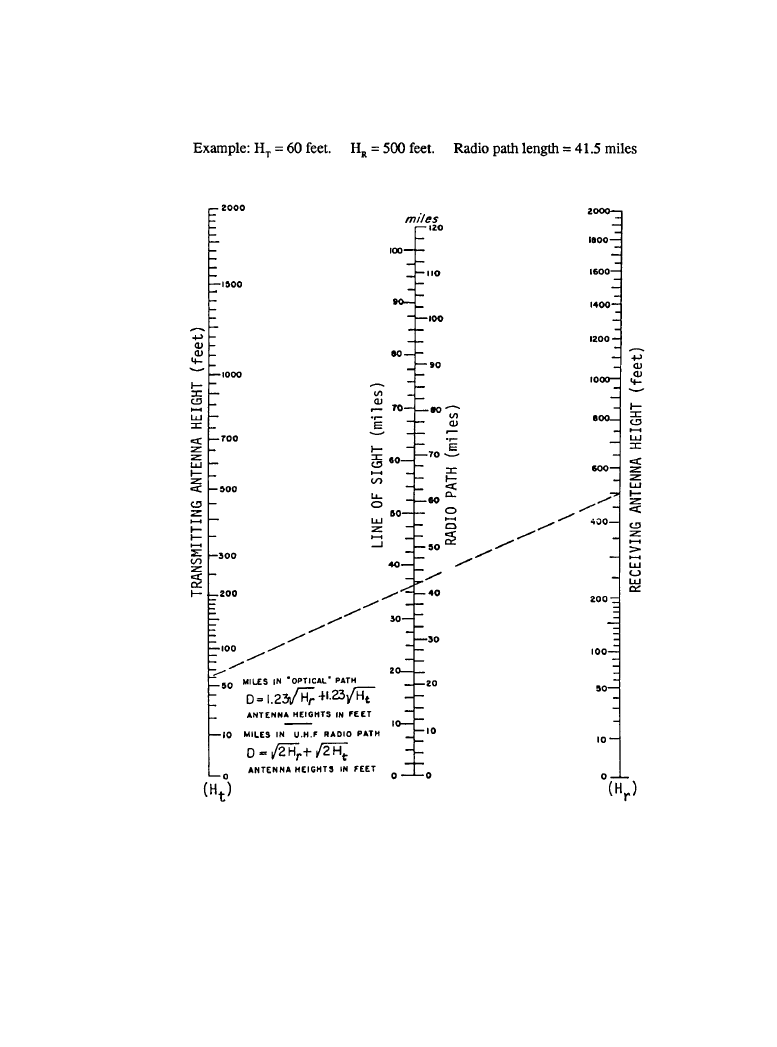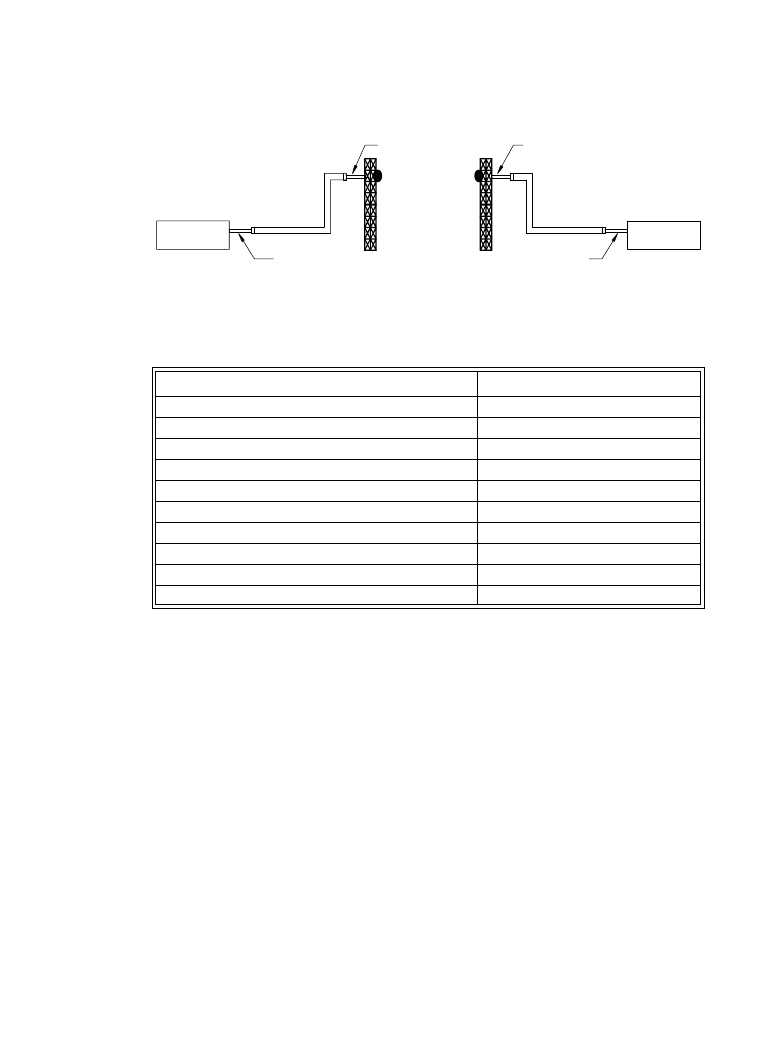ВУЗ: Казахская Национальная Академия Искусств им. Т. Жургенова
Категория: Книга
Дисциплина: Не указана
Добавлен: 03.02.2019
Просмотров: 21662
Скачиваний: 19

Radio STL Systems 11-77
Transmission Lines
Figure 11.4.14 shows the primary hardware elements required for an aural STL. Transmission
Figure 11.4.13
Nomogram to quickly determine if a path is viable. (
After [2].)
Downloaded from Digital Engineering Library @ McGraw-Hill (www.digitalengineeringlibrary.com)
Copyright © 2004 The McGraw-Hill Companies. All rights reserved.
Any use is subject to the Terms of Use as given at the website.
Radio STL Systems

11-78 Broadcast Transmission Systems
line sections, connections, and strain-relief provisions are important for long-term reliability.
The main criteria in the selection of transmission line include the following:
•
Amount of signal attenuation
•
Physical parameters (dielectric material and size)
•
Purchase and installation cost
In general, the larger the diameter of the transmission line, the lower the loss, and the greater
the cost of the line. Loss is also affected by the type of dielectric material used. The most com-
mon types of dielectric are air and foam. Air dielectric cable typically requires pressurization and
is, therefore, seldom used for 950 MHz installations. For the purpose of gain/loss calculations,
cable loss for a particular installation can be determined from the transmission line manufac-
turer's specification table, given in decibels per unit of measure. Attenuation for common types
of coaxial line are given in Table 11.4.5
Other electrical and mechanical specifications (mainly cable size and impedance) must be
compatible with the transmitter, receiver, and antennas to be used. Connector loss must also be
considered. It is important to minimize each potential source of signal loss when assembling the
system. There are no “minor details” in the installation of an STL.
Table11.4. 3 Conversion of Watts to dBm (50
Ω Impedance)
Power in Watts
dBm
Power in Watts
dBm
5.0
37.0
18.0
42.6
5.5
37.42
19.0
42.8
6.0
37.79
20.0
43.0
6.5
38.12
25.0
43.9
7.0
38.46
30.0
44.8
7.5
38.75
35.0
45.4
8.0
39.0
40.0
46.0
8.5
39.3
45.0
46.5
9.0
39.55
50.0
47.0
9.5
39.78
55.0
47.4
10.0
40.0
60.0
47.8
10.5
40.2
65.0
48.1
11.0
40.4
70.0
48.5
12.0
40.8
75.0
48.8
13.0
41.1
80.0
49.0
14.0
41.5
85.0
49.3
15.0
41.8
90.0
49.5
16.0
42.0
95.0
49.9
17.0
42.3
100.0
50
Downloaded from Digital Engineering Library @ McGraw-Hill (www.digitalengineeringlibrary.com)
Copyright © 2004 The McGraw-Hill Companies. All rights reserved.
Any use is subject to the Terms of Use as given at the website.
Radio STL Systems

Radio STL Systems 11-79
Table 11.4.4 Conversion of Microvolts to dBm (50
Ω Impedance)
Microvolts
dBm
Microvolts
dBm
0.10
–127
40
–74.9
0.12
–125.25
45
–73.9
0.14
–124
50
–72.9
0.16
–122.9
60
–71.25
0.18
–121.9
70
–70
0.20
–120.9
80
–68.9
0.25
–119
90
–67.9
0.30
–117.25
100
–66.9
0.35
–116
120
–65.25
0.40
–115
140
–64
0.60
–111.25
160
–62.9
0.70
–110
180
–61.9
0.80
–108.9
200
–60.9
0.90
–107.9
250
–59
1.0
–106.9
300
–57.5
1.2
–105.25
350
–56
1.4
–104
400
–54.9
1.6
–102.9
450
–53.9
1.8
–101.9
500
–52.9
2.0
–100.9
600
–51.25
2.5
–99
700
–50
3.0
–97.5
800
–49
3.5
–96
900
–48
4.0
–95
1000
–46.9
4.5
–93.9
1200
–45.25
5.0
–92.9
1400
–44
6.0
–91.25
1600
–42.9
7.0
–90
1800
–41.9
8.0
–88.9
2000
–40.9
9.0
–87.9
2500
–39
10
–86.9
3000
–37.25
1.1
–86
3500
–36
12
–85.25
4000
–34.9
14
–84
4500
–33.9
16
–82.9
5000
–33
18
–81.9
6000
–31.25
20
–80.9
7000
–30
25
–79
8000
–28.9
30
–77.25
9000
–27.9
35
–76
10,000
–26.9
Downloaded from Digital Engineering Library @ McGraw-Hill (www.digitalengineeringlibrary.com)
Copyright © 2004 The McGraw-Hill Companies. All rights reserved.
Any use is subject to the Terms of Use as given at the website.
Radio STL Systems

11-80 Broadcast Transmission Systems
Stain relief must be provided on each end of the cable run (at the transmitter and at the
receiver). So-called pigtail or jumper cables are commonly used for this purpose. They permit
movement without straining cable and chassis connections. Because the pigtails commonly are
terminated with N-type male connectors on both ends, the main transmission line must be con-
figured with female N-type connectors on both ends if a pair of pigtails are used.
Antenna System
At the frequencies commonly used for STL operation, antennas can readily focus the signal into
a narrow beam. This focusing, required for point-to-point communications, provides high gain at
both the transmitter and the receiver. Several types of antennas are available, including parabolic
and parabolic section. Parabolic antennas are available in solid or grid styles, while parabolic
section antennas usually are grid-type in design. Antenna models differ in a number of respects,
including:
•
Gain (directly proportional to size)
•
Operating frequency range
STL
transmitter
STL
receiver
Transmission line
Pigtail
Pigtail
Antennas
Pigtail
Transmission line
Pigtail
Figure 11.4.14
Principle physical components of an STL system. (
After [2].)
Table 11.4.5
Typical Coaxial Transmission Line Loss at 950 MHz
Cable Type
Loss (dB/100 Feet)
RG-8/U
8.5
RG-218/U
3.8
1/2-in foam dielectric
3.0
7/8-in foam dielectiic
2.0
1/2-in low-loss foam dielectric
2.4
7/8-in low-loss foam dielectric
1.4
1-5/8-in foam dielectric
1.4
1/2-in air dielectiic
2.7
7/8-in air dielectric
1.4
1-5/8-in air dielectric
0.7
Downloaded from Digital Engineering Library @ McGraw-Hill (www.digitalengineeringlibrary.com)
Copyright © 2004 The McGraw-Hill Companies. All rights reserved.
Any use is subject to the Terms of Use as given at the website.
Radio STL Systems

Radio STL Systems 11-81
•
Polarization (most antennas can be set for either horizontal or vertical polarization using uni-
versal mounting hardware kits)
•
Beamwidth
•
Front-to-back ratio
•
Windloading
•
Structural strength
Environmental factors may also need to be considered so that suitable antenna accessories,
such as deicers and/or radomes, are specified.
Antenna gain is specified in decibels referenced to an isotropic antenna (dBi) or decibels ref-
erenced to a dipole antenna (dBd). Conversion from dBd to dBi is as follows:
dBi = 2.2 + dBd
(11.4.1)
For path analysis calculations of system gains and losses, dBi is used.
Figure 11.4.15 plots the response of a common type of STL antenna. Note the high directivity
provided by the device and the difference in gain between operation in the 450 MHz band as
opposed to the 950 MHz band. Table 11.4.6 lists the typical gain provided by antennas of differ-
ent physical size.
Mounting Structures
Each antenna requires a mounting structure, such as the side of a roof or building, or an existing
or custom-built tower. The structure must be sufficiently high to mount the antenna at the mini-
mum elevation determined by STL path calculations. The structure must also be capable of sup-
porting the weight of the antenna and transmission line, as well as withstanding any forces that
affect the antenna tower, such as wind and the weight of snow and ice. Be certain to take into
account the mounting hardware used with the antenna, which typically accommodates pipe up to
a diameter of 3.5 in. Provisions must be made to secure the transmission line. The structure may
also be subject to local building and zoning codes. Strict adherence to these codes is mandatory.
Adequate physical clearance must be considered to allow for proper horizontal and vertical
alignment during installation.
Hardware Considerations
Depending on the complexity of the STL system, additional hardware may be required. Where
more than one transmitter or receiver is used with a single antenna, a combiner, splitter, or
duplexer will be needed. These items contribute additional loss and must be accounted for in
path calculations.
Certain installations may require the installation of an external power amplifier in cases
where the output of a standard STL transmitter is insufficient for a particular path. In path calcu-
lations, the power output of the external power amplifier (converted to dBm) is substituted for
the output of the STL transmitter. In general practice, most engineers choose to use an external
power amplifier only as a last resort. Higher gain antennas usually are a more attractive alterna-
tive.
Downloaded from Digital Engineering Library @ McGraw-Hill (www.digitalengineeringlibrary.com)
Copyright © 2004 The McGraw-Hill Companies. All rights reserved.
Any use is subject to the Terms of Use as given at the website.
Radio STL Systems